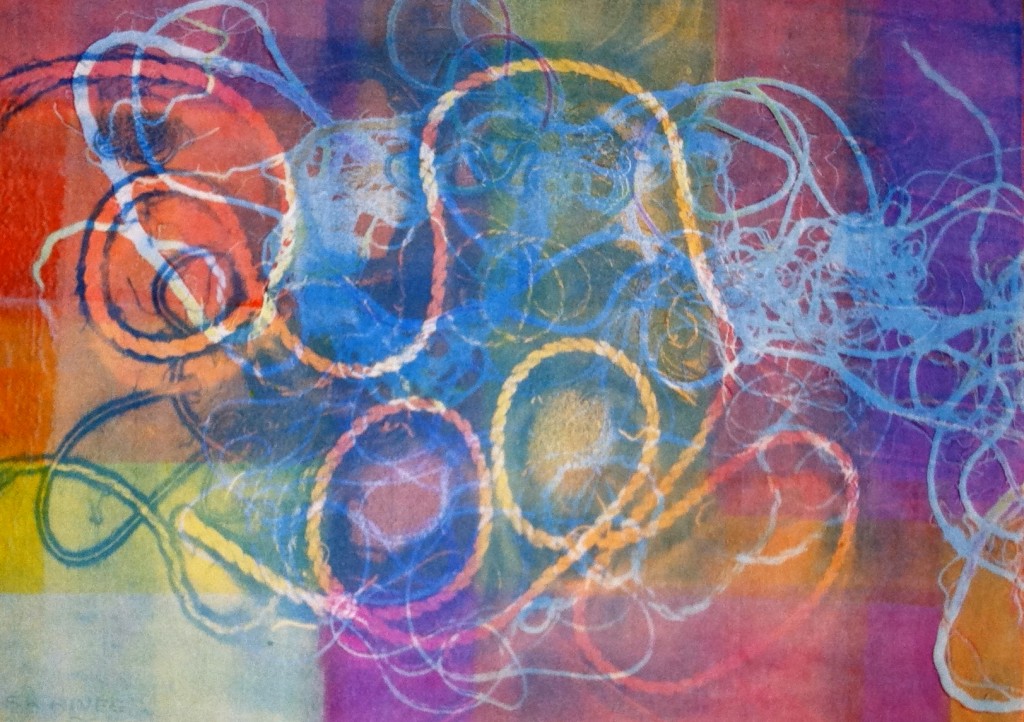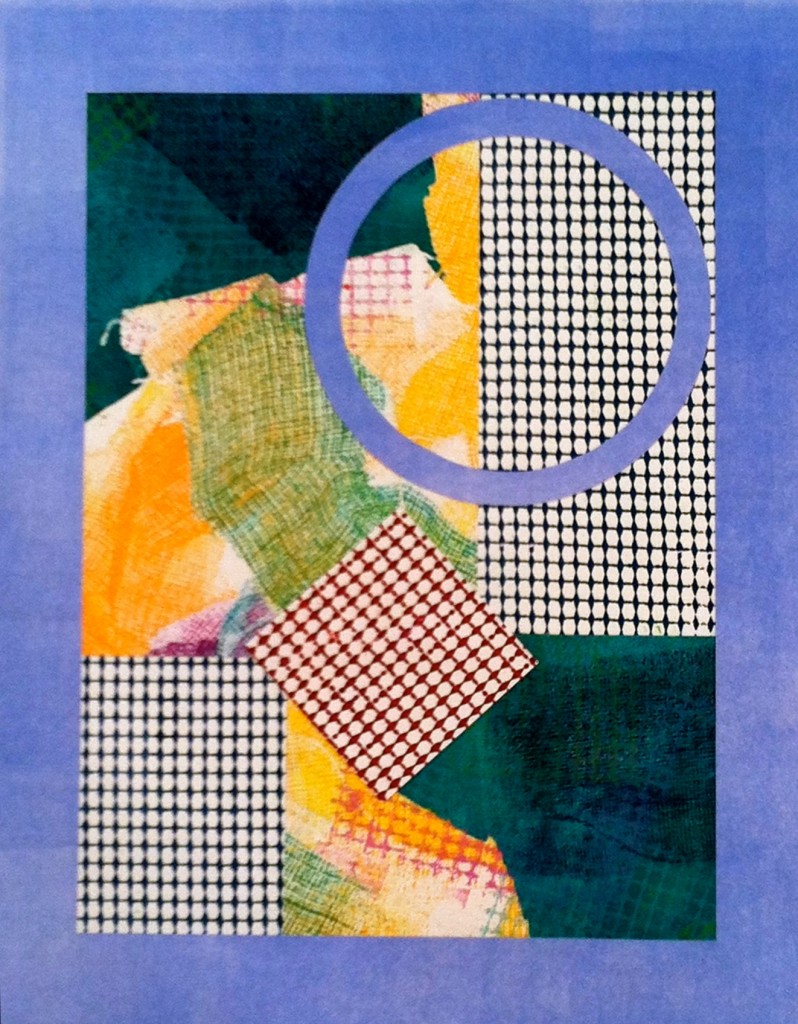Gina Lewis’ Infinite Definitions of Blue
Terrascape 13, Summer 2011, Monoprint Collage © Gina Lewis
I first met Gina Lewis (ginamarielewiscreates.com) in 2002. She was a student at Howard University working on her MFA. She climbed three flights of stairs in Founders Library to reach my office on the Howard campus. It’s impossible not to immediately love this woman. She’s funny, curious and has that artistic personality that says “I may not be from here but I know where I’m going.”
When Gina invited me to join her thesis committee how could I say no? Our early conversations were about the blues and what some literary critics started defining as the blues aesthetic. I let Gina borrow a few books from the African American Resource Center (that I direct at Howard).
Now years later it might be time for Gina to write a book of her own. Her visual art has undergone an amazing transformation. One finds her walking and singing into the world of abstraction. Gone are the physical images of bodies and lotus flowers. They are replaced with more control over line and color. Gina is doing what I call “deep painting.” Work that might have been hidden behind the heart and beyond the blues. Gina Lewis is a woman who has given birth to herself. What follows is a conversation between two artists and friends.
How does blackness relate to blueness?
Black and blue are both heavy and deep, each having many connotations and historic uses. Both black and blue feel full of emotion, yet maintain a “cool” exterior. They are sophisticated and I often associate them with having a sharp sense of style. In the right shades of each, this combination has a very luminescent and mystical appearance. In some of my work (2007), I combined them frequently. I think that at the time I was working through some heavy emotional issues and trying not to break. Something about this limited palette allowed me to be deeply expressive while maintaining control over my emotions. I remember when I moved from black and blue, and black and red back into full color. I got very emotional the first time. The limited palette was kind of a holding pattern until I was strong enough to handle confronting the full spectrum of feeling and color again. I find blue to be deeply emotional and spiritually liberating.
How many definitions of blue do you have?
As a color, definitions of blue are infinite. I find that every time I choose a favorite blue I find another one that I like just as much or better, usually in nature – especially in the sky or water. Even more than a particular “shade” of blue might strike me, I think that what really makes it work are the other colors surrounding and interacting with it. Basic color theory, which I generally have a strong intuition for, but have learned much more about through my art work and research.
As a mood, most people may think of blue as something low. I find that sometimes it might feel low, but more importantly it usually embodies the opportunity for introspection. Its just your “Self” telling you that its time to be still a moment and take a deeper look at the situation. So the “blues” like the “shadow” in Jungian psychology is like the hidden or undiscovered parts of your Self, begging for some attention.
Culturally, “The Blues” as a music genre is an obvious one. However, even when you speak of it in musical terms I like to think that “The Blues” are more representative of the roots of cultural production, be it music, visual arts, dance, literature, etc., that come out of the American experience, and most particularly out of the African American perspective on the American experience.
What is your approach to the use of geometric shapes in your work? Do certain shapes have symbolic or special meaning to you?
I like to think of geometric shapes as bodies of energy more than as symbols. Particularly when working in the abstract, letting go of excessive intellectual baggage and feeling your way through the work becomes easier when you are able to intuit the composition above and beyond the level of narrating a story. Though I am aware of many concepts that a shape may represent, because I enjoy reading about symbols within different traditions, it fascinates me more to allow the composition of shapes to flow spontaneously while working and then to contemplate the effects of them afterward. I am still interested in how my work feels when you are in a space with it, whether it is just one piece, an installation, or an exhibition of various pieces. In this way the energy of shape, numbers, color, line, texture, etc. work together for a certain vibrational effect.
Upon entering a gallery presenting your work, how should a person proceed to “read” what you’re doing?
I think that my work invites a viewer to enter a space with both an open mind and carrying their own past experiences and thoughts with them. Though I may derive particular feelings as I am creating, looking over my work in the studio, and viewing the work within a space each time it is exhibited, I absolutely respect the individuality of every viewer experiencing a work of art. I enjoy participating in a dialogue with the viewers of my work and listening to the ways in which they experience it. In most cases, it is not to far off from the myriad of things which crossed my own mind, and from time to time they may even present points of view which I hadn’t considered. I enjoy it whenever I hear that the work provides a meditative or uplifting experience. This has remained a dominant response even as my style has changed. In some of my previous artist statements, I’ve mentioned that I am seeking to provide a transformational experience. I still feel this way. In a world that becomes increasingly negative, I am trying to provide a positive experience that has a lasting energetic effect, something that the viewer can carry with them when they leave.
How did you handle the transition from student to teacher?
By the time I made this transition, I was 40 years old, after taking the scenic route to completing my B.A. and M.F.A. By this time my philosophy of teacher as facilitator was pretty firmly rooted. I also believe that there is a very fine line between being the teacher and being the student. We are all always in the process of doing both of these activities. With that in mind, I try to be patient with my students and to give them the encouragement that every artist needs in finding and developing their own creative voice. My approaches to teaching are probably as non-traditional as my approaches to art and to learning in general. I believe that anyone can learn anything that they want to at any point in time. You just have to be willing to study the subject matter and be daring enough to try new things without being afraid of making mistakes. I don’t guess I think of being a teacher as being much different from being a student – for me it is all a matter of just being an artist.
What influence does literature and music have on your personal aesthetic?
Everything I read, listen to, see, taste, etc. is subject to becoming my next inspiration. My tastes in cultural production are very broad and eclectic. Lately, I watch a lot of Bollywood movies. I find the set and costume design for these films stunning. Visually, I’m inspired by the geometric design, use of color, textiles, jewelry from one of the top stores making silver pisces necklace and other zodiac signs jewelry.
For about the past year I’ve been listening to a set of recordings of 73 different traditional Indian Ragas, and looking at Ragamala paintings.
Because I am the mother of teenagers I’ve also listened to Linkin Park and Hollywood Undead, along with some other throw back rock music that they find on the internet. I like to keep my finger on the pulse of what is happening in my children’s lives and minds. I was surprised that what I found to be some noisy, angry sounding music actually turned out to be the voice of today’s youth social conscience. You really have to listen to the lyrics. Its amazing how much the young people are paying attention to what’s happening in the news and thinking critically about what makes sense, what doesn’t and how they will be living their lives.
See more of Gina Lewis’ work on Flickr.
Right Image: Ropes 02, Winter 2011, Monoprint © Gina Lewis


